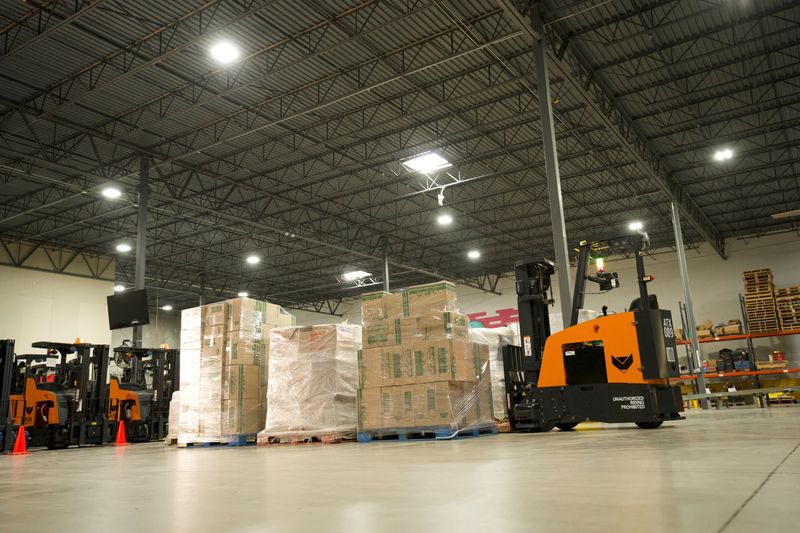By Siddharth Cavale and Jeffrey Dastin
NEW YORK (Reuters) - Walmart (NYSE:WMT) has plans to potentially spend $200 million on self-driving forklifts as part of broader efforts to automate more warehouse operations, according to three people familiar with the matter.
The world's largest retailer wants autonomous forklifts to move pallets of goods in its distribution centers, which replenish Walmart stores. It has intended to buy possibly hundreds from Fox Robotics and invested $25 million in the Austin-based startup, the sources said.
The rollout, which Walmart could stop at any time, would occur in stages over several years and hinges on the retailer's satisfaction with the "FoxBots," said the people, who were not authorized to discuss the plans publicly.
Details about Walmart's investment and rollout have not been reported before. They underscore the company's strategy for warehouse automation, which aims to grow profit and help it compete with retailers like Amazon.com (NASDAQ:AMZN).
Camille Dunn, a Walmart spokesperson, declined to comment on the $200 million spending plans. She referred Reuters to an April announcement that said Walmart had piloted the technology and would add at least 19 FoxBots to four facilities, noting that deployments are "an evolving process" from proof of concept to rollout.
"We evaluate the performance at each phase to determine if the technology meets our ability to better serve customers," she said in an email. "Some initiatives we scale, some initiatives we don't."
Fox Robotics said its customer deals are confidential.
In recent years, Walmart has focused increasingly on robotics to help it replenish stores, manage costs and keep the price of goods low.
Analysts from Jefferies estimated the company could add $20 billion to its profit before interest and taxes by fiscal 2029, thanks to its efforts in automation and artificial intelligence. Arun Sundaram of CFRA Research added: "Expect more and larger deals in the future."
As one example, Walmart announced a deal in 2022 with the robotics vendor Symbotic to implement automation in 42 distribution centers. Walmart owned more than 13% of Symbotic stock as of a January securities filing.
Now, Walmart has taken a stake in Fox Robotics and has warrants to invest more, the people familiar with the matter told Reuters.
The Fox and Symbotic deals are similar in that they restrict use of their technology by Walmart's biggest competitors, the sources said. Exclusive deals with suppliers are not uncommon in retail.
The Symbotic agreement states that key employees would be bound by non-competes and receive competitive pay, while Symbotic would be barred from selling its technology in certain non-Walmart warehouses. Details were redacted in a securities filing.
Walmart declined to comment on its contractual agreements with the robotics vendors. Symbotic said it does not comment on its customers' business strategies.
STEMMING TURNOVER
Tested for more than a year, the FoxBots unload pallets and help put them into Symbotic's automated system, which catalogues and stores goods, Walmart has said in press releases.
A single human operator can manage up to six of the autonomous forklifts at a time, saving as much as 40% on labor costs, Fox Robotics said on its website. A worker is still needed to open warehouse doors for instance, but the goal is for Walmart to depend less on labor in the long run, the sources said.
Dunn said, "People will always be part of our warehouse operations."
Finding workers to staff warehouse and other blue-collar jobs can be challenging, two of the sources said. Employers might pay little for onerous work, and sometimes staffers do not show up, one of them said. "There's a younger generation of people that just don't want to do these jobs," the source said.
At Walmart, a freight handler at its Coldwater, Michigan distribution center might "lift up to 40 to 60 pounds repetitively for extended periods of time," according to a job posting on Glassdoor. Another ad asked if a candidate had proficiency in operating equipment such as a forklift and would work 12-hour or overnight shifts, for $19.30 to $24.80 an hour.
For David Guggina, executive vice president of supply chain operations at Walmart U.S., automation has meant new technical roles for associates and other employment opportunities, not job cuts. It reduces physically demanding work, giving Walmart "substantially low turnover," he said.
"A reduction in turnover absolutely drives savings," Guggina told Reuters. "You improve your productivity because you have less folks that are sitting in what I call (the) learning curve."
Asked how much Walmart was spending on automation overall, Guggina said Walmart was investing billions of dollars into its supply chain network.
In spite of their promise, robotics have not always paid off for the company, which pulled the plug on shelf-scanning units in its stores years ago.

Their long-term feasibility can be uncertain, depending on significant adjustments and a controlled environment, whereas humans can adapt faster, said Katie Driggs-Campbell, a professor the University of Illinois’ Grainger College of Engineering.
"We are still far away from the robotics replacing humans in the retail industry," she said.